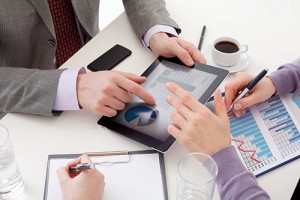 It used to be that information technology was the domain of specialists. In the last 10 years, the adoption of new technology has shifted to the consumer and not the enterprise. As a result, employees who were accustomed to using technology at home pushed for adoption in the workplace. This left IT groups scrambling to adapt their policies and applications to work with consumer devices and software, not always willingly.
It used to be that information technology was the domain of specialists. In the last 10 years, the adoption of new technology has shifted to the consumer and not the enterprise. As a result, employees who were accustomed to using technology at home pushed for adoption in the workplace. This left IT groups scrambling to adapt their policies and applications to work with consumer devices and software, not always willingly.
This consumerization of technology inspired the popularity of bring your own device (BYOD) to work. The two main concerns over this trend are first and foremost security and second, compatibility with corporate applications. While it is desirable to access data and applications anytime, anywhere, and on any device, it is not always easy or safe. In this blog post I will look at the history and future trends of the IT consumerization. Will we continue as we have, or will the enterprise once again take the lead in new technology adoption?
History
Computers were originally used in government and businesses for things such as bomb trajectory calculations in World War II, tabulating voters’ ballots for presidential elections, and organizing corporate accounting activities. Operators and programmers were in charge of running the computers and any task or requests had to be fed through them. The query results came as printouts, not displayed on a desktop screen. Even as late as the mid-1980s I remember working in a large computer room where we printed stacks of paper that were set outside the computer room to be retrieved. Only computer operators and technicians were allowed inside the room. Access to the computers was through dumb terminals as input and the generated paper results as output.
Personal Computers
Apple and other companies sold computers to hobbyists in the late 1970s. While this was technically a consumer product, it was considered a niche market. When IBM introduced the personal computer in 1981, it was targeting the corporate employee, not individual consumers. When user-friendly word processing and spreadsheet software became available, consumers began buying computers for home use.
Networking
Without connecting the home computer to the outside world, people were still left with the same problem of input and output. Input came through the keyboard or from a disk, and the output came to a printer or screen or to another disk. The disks had limited capacity so to share a program or data, one had to have multiple disks that were hopefully labeled correctly. With early dial-up modems, people could finally share information (not graphics, that would take forever) with each other. As consumer networks improved, so did our desire to connect and share things with each other and the lines between work and home began to blur.
The Tipping Point
The tipping point for the consumerization of IT came with smartphones and tablets. Laptops were certainly more mobile and could go back and forth from home to work, but the smartphone and tablet made it even easier to live in both worlds. IT departments initially rejected tablets as not being robust and secure enough for the enterprise. The smartphone was even worse because it was so portable. Blackberry was one of the pioneers in bridging the gap between corporate e-mail and information systems and consumer devices. Salespeople and executives could receive information while they were with a client instead of waiting for a computer operator to process a request. It was a whole new world that continues to evolve.
Today
In my Information Systems class we talk about Bring Your Own Device (BYOD) and the tools that we need to deploy, such as Mobile Device Management (MDM), in order to integrate consumer devices into the workplace. The key for technology departments is adaptability. The lines are blurred and the genie is not going back in the bottle so we need to make sure our data and enterprise are secure while working with these devices.
In a possible reversal of trends, Deloitte predicts what they call the re-enterprization of IT in the next few years. They point to current technologies such as wearables, 3D printing, and drones being embraced by the enterprise as evidence of that reversal. I am skeptical that the consumer trend is changing just yet but I will keep my eyes open.
Thoughts
Has the consumerization of IT helped you in your work or has it caused you pain as you deal with the consequences? I don’t miss the days of wearing a separate pager and I love being able to access data from any device at any time. I also realize the work that goes into the back end to make this access seamless and I appreciate the efforts of technologists who build bridges between consumer devices and the enterprise. Let me know your thoughts.
Kelly Brown is an IT professional and assistant professor of practice for the UO Applied Information Management Master’s Degree Program. He writes about IT and business topics that keep him up at night.


